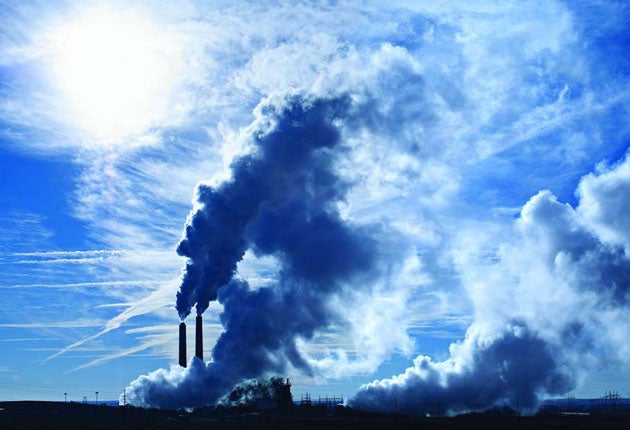The Big Debate: on the eve of Cancun, can we cut carbon in time?

With no action beyond what we are already taking, the 2007 Fourth Assessment Report by climate scientists on the UN’s Intergovernmental Panel on Climate Change (IPCC) projects the planet will warm by between 1.1C and 6.4C over the next 100 years.
That doesn’t sound much, but as well as warmer days and nights, rising sea levels and coastal flooding, it would mean extreme weather, with deadly heatwaves like that of 2003 becoming commonplace. There would be flash floods, droughts, famines, storms, increased desertification of semi-arid regions, and frequent fires ravaging global forests. This would create environmental refugees and threaten conflicts.
An increase of just 1.5C to 2.5C could spell extinction for 20-30 per cent of all species, and above 3.5C, 40-70 per cent of global species could be wiped out. Despite “Climategate”, these predictions hold.
What do we need to do?
Most accept it will now be very difficult to avoid a 1.5C rise. Current climate policy aims instead to limit warming to below 2C to avoid the most severe impacts. The 2007 IPCC report warned that a reduction of at least 25-40 per cent in emissions from industrialised countries will be needed by 2020 compared to 1990 levels, but a cut of at least 80-95per cent by 2050 will be needed to side-step the worst effects of climate change and ultimately achieve climate stabilisation. Major developing countries will also need to contribute if we are to achieve the overall 50 per cent global cut needed by 2050, but deep emissions cuts in these rapidly growing economies are unlikely before 2030.
But in reality, even this would only give us an even chance of avoiding catastrophe, without considering potential rapid climate change. We also need to ensure resources are there to enable vulnerable nations to adapt.
The EU has unilaterally committed to a 20 per cent emissions cut by 2020 relative to 1990, but offers 30 per cent if other major emitters make comparable efforts. In the UK, Labour set up reducing five year emissions budgets under the Climate Change Act 2008, but it now falls to the Coalition to set the detailed framework for the £200 billion investment needed on low carbon generation up to 2020. Even meeting the
UK’s pre-climate deal 34 per cent emissions reduction target for 2020 will need a step change, depending on new energy efficiency measures, new levies on utilities and a carbon tax, a well-funded Green Investment Bank, and positive involvement from the Treasury as well as private capital.
What was agreed at Copenhagen in 2009?
Two years earlier, global leaders in Indonesia agreed a roadmap to a new climate treaty by Copenhagen. The Bali Roadmap broadly followed IPCC recommendations.
But at Copenhagen, developed countries insisted on deep emissions cuts from key developing economies that have so far been exempt under Kyoto as the price for their own reductions and for supporting a global adaptation fund of $100 billion a year by 2020. China and other emerging economies refused to accept binding curbs and verification, and insisted on greater concessions on technology and funding. Consequently, the EU held back on its higher target.
A last-minute deal was brokered largely between leaders of the USA, Brazil, India, China and South Africa – the Copenhagen Accord. This preserved some of the key elements needed in a future deal, but it is non-binding and emissions pledges made would still leave the world facing disastrous 3C warming by 2100
So what can we expect from Cancun 2010?
No one now expects divisions to close in time for a full climate deal at Cancun, but outgoing UN climate chief Yvo de Boer said earlier this year that we should at least expect key aspects of the architecture to be settled, increasing the chances of concluding a full treaty the following year in South Africa. These need to cover emissions reduction targets and agreed verification systems, adaptation funding, technology transfer, capacity-building, finance, and avoided deforestation. There also needs to be clarity over the legal status of a new treaty or suite of treaties. Developed countries need to raise their game, while major developing countries must take on more of the carbon-cutting burden in ways appropriate to their circumstances. Business also needs long-term policy stability beyond 2012 to prevent further loss of confidence in carbon offset projects and to foster capital-intensive low carbon technology markets.
So can we do it?
We still have a good chance of avoiding dangerous climate change, but sustained political will at national and international level will be crucial. And we would need to go substantially beyond a 25-40 per cent cut in emissions to be sure of success. Timing is also critical and we have barely begun – a staggering $10.5 trillion low carbon investment will be needed globally to allow climate stabilisation. This will provide huge opportunities for new green industries – much of it is necessary in a world facing growing pressure on resources. But each year of delay adds another $500 billion, meaning much deeper and less politically acceptable cuts later with increased risk of policy failure.
Dr Paul Hatchwell writes on energy and carbon for the Ends report, the UK journal and website for environment business and policy, www.endsreport.com
Join our commenting forum
Join thought-provoking conversations, follow other Independent readers and see their replies
Comments